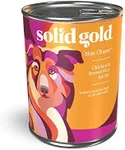Buying Guide for the Best Dry Dog Food
Choosing the right dry dog food for your pet is crucial for their health and well-being. The right food can help maintain a healthy weight, provide essential nutrients, and support overall health. When selecting dry dog food, it's important to consider several key specifications to ensure you're making the best choice for your dog's specific needs.IngredientsIngredients are the components that make up the dog food. This spec is important because it determines the nutritional value and quality of the food. Look for high-quality ingredients like real meat, vegetables, and whole grains. Avoid foods with fillers, artificial preservatives, and by-products. If your dog has allergies or sensitivities, choose a formula that avoids those specific ingredients.
Protein ContentProtein content indicates the amount of protein in the dog food, which is essential for muscle development and overall health. This spec is important because dogs need a certain amount of protein to thrive. For puppies and active dogs, look for higher protein content (around 25-30%). For adult dogs with moderate activity levels, a protein content of 18-25% is usually sufficient. Senior dogs may require lower protein levels, depending on their health.
Fat ContentFat content refers to the amount of fat in the dog food, which provides energy and supports skin and coat health. This spec is important because the right amount of fat helps maintain a healthy weight and energy levels. Active dogs and puppies may benefit from higher fat content (around 15-20%), while less active or overweight dogs may need lower fat content (around 8-12%).
Fiber ContentFiber content indicates the amount of fiber in the dog food, which aids in digestion and helps maintain a healthy weight. This spec is important because fiber helps regulate bowel movements and can prevent constipation. Look for fiber content between 3-6% for most dogs. If your dog has digestive issues, you may need a formula with higher fiber content.
Life StageLife stage refers to the age and development stage of your dog, such as puppy, adult, or senior. This spec is important because dogs have different nutritional needs at different stages of life. Choose a formula specifically designed for your dog's life stage to ensure they receive the appropriate nutrients. For example, puppy formulas are higher in protein and fat to support growth, while senior formulas may have added joint support and lower calories.
Breed SizeBreed size indicates whether the dog food is formulated for small, medium, or large breed dogs. This spec is important because different breed sizes have different nutritional requirements and kibble sizes. Small breed formulas often have smaller kibble and higher calorie content, while large breed formulas may include joint support and controlled calorie content to prevent obesity. Choose a formula that matches your dog's breed size for optimal health.
Special Dietary NeedsSpecial dietary needs refer to any specific health conditions or dietary restrictions your dog may have, such as allergies, sensitivities, or medical conditions. This spec is important because it ensures your dog receives the right nutrition without triggering any health issues. Look for formulas labeled for specific needs, such as grain-free, hypoallergenic, or weight management, to address your dog's unique requirements.




















